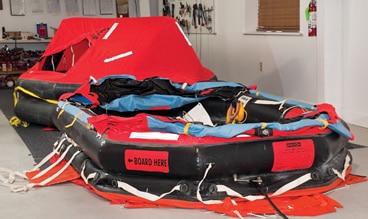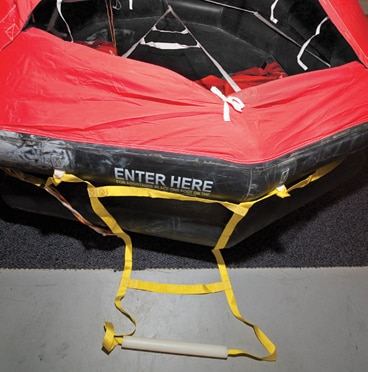
Murphy was an optimist. I say it often and often add expletives. Considering a life raft only comes into play after at least two things have gone horribly wrong — the initial catastrophic event and inadequate shipboard systems to resolve it — neglecting life raft service seems like an ill-intended salute to Murphy, Neptune and Mother Nature all at once. Yet many boaters do it. Some think emergencies won’t happen to them. Others pass off manufacturers’ service recommendations as overkill. Here’s what those service dollars buy beyond peace of mind.
At each inspection, be it annually or every three years, service personnel inflate life rafts with compressed air (not on-board C02 cylinders, which stress rafts with each use). Rafts are first over-inflated to 150 percent of rated pressure, then relaxed. Next they’re re-inflated and precisely monitored over time to ensure they don’t leak. Holding air is, after all, the number-one necessity of a life raft.

Rafts are also checked for questionable seams and floor, canopy or tube connections. Experienced service personnel know what to scrutinize most closely — glued seams on PVC or urethane rafts, sticky or gummy panels where heat and moisture work on rubber and signs of mold or fungus that attack raft material like a cancer. Inspection ensures rafts will stay in one piece.
Safety gear is also checked. Flashlight batteries, repair kit glue and seasick pills are replaced annually. Flares and first-aid kits are changed every three years. After either five or six years, drinking water, water-activated light lithium batteries and food, if applicable, are replaced. These items are redundant to ditch bags, but critical inflation mechanisms are also inspected each time and given major service every five or six years.

When repacked, life rafts are folded so creases fall differently, another important reason to service rafts on schedule even when in storage. Vacuum bags are replaced or inspected to avoid moisture intrusion that will quickly ruin a raft.
If caught early, most problems can be repaired and further damage prevented but only within strict parameters. Even on rafts stored indoors, a burst water container or leaky flashlight battery, if left for years, can ruin a raft. Service is expensive, but delaying service can cost more, and going offshore with an unserviced raft may well exact the ultimate price.

Visit Your Life Raft
You’re twice as likely to survive an emergency if you know how to use your survival gear. It’s a statistic often cited but that can’t be verified. It reflects experiences of shipwreck survivors but can’t include accounts of those who never came home. But if you doubt the fact, imagine meeting your raft for the first time while swimming in 6-foot seas, in the dark, without your glasses, with your eyes burning from diesel fuel and under the stress of knowing loved ones are also in the water, hopefully nearby. What odds would you give yourself? To increase them, visit your raft when it’s serviced or at a boat show and ask questions.
The first priority is knowing how to launch the raft. Next comes righting it from the boat deck or from the water if it inflates upside down. Also learn how to board the raft from the boat or when swimming — the strongest passenger boards first to help others. Know as well where the knife is stored to cut the painter attached to a sinking boat and when not to do so. Find the heaving line inside the raft used to reach others still swimming or for yourself if rescuing those who aren’t swimming, and know how to douse the sea anchor and paddle to leave a burning boat or reach others.

Once everyone is safe on board the raft, your priority will turn to canopies and inflatable floors to stay dry and retain body heat, but experts advise to immediately task someone to the EPIRB and distress signals while another scans for possible rescue. Not being prepared to signal when an opportunity arises elicits another unverifiable statistic — how often that was the only opportunity.
Finally, turn your attention to the survival guide and equipment typically lashed to the raft floor. All should take seasickness medication right away. If it might be a while before rescue, you’ll also want to turn off automatic lights during the daytime.
The U.S. Coast Guard is asking all boat owners and operators to help reduce fatalities, injuries, property damage, and associated healthcare costs related to recreational boating accidents by taking personal responsibility for their own safety and the safety of their passengers. Essential steps include: wearing a life jacket at all times and requiring passengers to do the same; never boating under the influence (BUI); successfully completing a boating safety course; and getting a Vessel Safety Check (VSC) annually from local U.S. Coast Guard Auxiliary, United States Power Squadrons(r), or your state boating agency’s Vessel Examiners. The U.S. Coast Guard reminds all boaters to “Boat Responsibly!” For more tips on boating safety, visit www.uscgboating.org.








